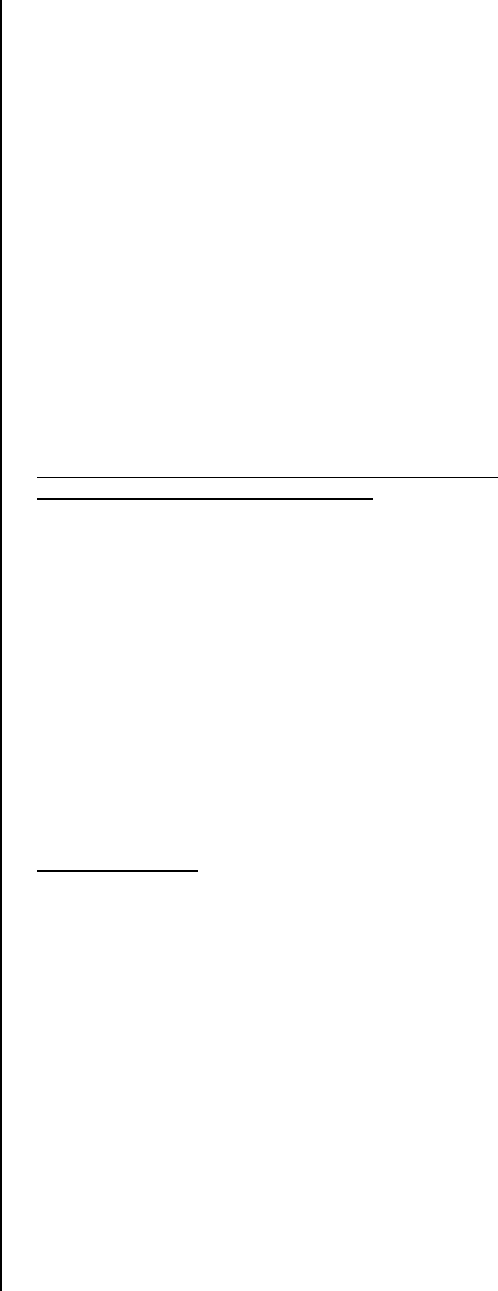
I send tracks out to mLAN 1&2 of the software, I
can monitor them on the 01X. (Substitute the
“software” for “computer”. You could in other
setups route the return to any mLAN channels.
Eventually, in a mixdown scenario you would
naturally return more channels to the 01X. But
here we are only monitoring the signal in stereo.
Connecting outputs from the hardware to tracks of
the digital audio workstation software can now be
understood. The software (depending on which
one) will see the inputs coming from the 01X as
24 inputs. It will refer to them as mLAN inputs 1
through mLAN inputs 24. Don’t let this throw you.
The computer only ‘knows’ what it can ‘see’. In
other words, you might be addressing a signal in
the 01X on mLAN1 (which is really the 9
th
channel
of to the 01X), well… the DAW might refer to this
as mLAN(9). When you are routing signal to the
DAW via Direct outs (a common situation) where
after you EQ and process through the dynamics
processor you send the signal “direct” to the DAW.
The DAW then naturally sees the AD1 as mLAN1,
AD2 as mLAN2, and therefore, the 01X’s mLAN1
becomes mLAN9 to the DAW. Not a problem if you
understand the routing. Also not a problem
because you can name the tracks – and the
names will be reflected in the screen of the 01X.
This is a good reason to name your tracks – and
use a system that works for you to do this. Once
you have named the tracks it is easy for you to
know what is arriving where.
In our setup the i88X has 8 of its potential 18
outputs connected to the 8-mLAN INPUTS of the
mLAN16E. The Motif ES can receive 4 stereo pairs
of inputs as AUDIO INPUTS – you can monitor
and/or send on to the 01X and on to the computer
any signal plugged into the i88X.
• Plug a microphone into input 1 of the i88X
• It will arrive in the Motif ES as an AUDIO IN: Press
EDIT/ Press COMMON/ Press F5 AUDIO IN/ Use the
SF5 button to toggle between AD, mLAN1, mLAN2,
mLAN3 and mLAN4. The currently selected AUDIO
INPUT will be indicated in the upper left corner of
the screen.
• You can monitor it (as it is returned to the L&R outs
by default)
• You can assign this to any one of the assignable
outputs (as1-as14) – it will arrive in the 01X on that
mLAN input.
• You can add effects (these effects will be routed to
the monitors, only) – the signal that you send to the
DAW will be post 01X EQ, post 01X Dynamics, but
pre the EFFECTS – so you can print the track
without reverb but with EQ and a Compressor…this
is very cool.
Of course you could use the patchbay to send the
i88X input directly to the 01X or directly to the
computer…it is your choice. This is just one
particular setup. In this setup you could use the
i88X to bring signal into the Motif ES for a high-
end sampling session. Part of what you want to do
is understand what you have and then start to
think about all the possibilities. There is no ‘one
way’ to setup and work. If you have a professional
recording console, a multi-track recorder, a
patchbay with 50 audio patch cables and a couple
of racks full of high quality gear – there are so
many ways to make it all work – trying to
describe every setup would be impossible…and so
it is here – because that is just what you have.
The mLAN system opens the possibilities to the
creative user that never existed before. As you
can see from this setup, not all gear has to be
mLAN to exist in the network – this is a key point.
mLAN is designed to work with gear that connects
via standard XLR, ¼” jacks, and 5-pin DIN MIDI
jacks.
Why use the Multi-Part Editors instead of the
DAW’s mixer map or definition list? The typical
script list or definition in software sequencers will
only memorize the Voice that you used per Part.
They do not memorize the entire Motif ES/Motif
Rack MIX. The Yamaha Multi-Part Editors will
archive all the User Voices currently in the Motif
ES/Motif Rack – so you can select even User
Voices by name, and it will let you access the
entire MIX> Voice, pan, volume, effects, effect
sends, insertion effect assignments, note shift,
pitch bend range, output assignment, etc., etc.
When you recall the Multi-Part Editor for Motif ES
6/7/8 file (.m2e) and the Multi-Part Editor for
Motif Rack file (.m1e), it is an archive of what is
happening in your Motif ES and Motif Rack,
including all the User Voices.
Remote Control: When you want to adjust the
Mix of the Motif ES you can use the 01X General
Remote function to access the synth.
• Press [SHIFT]+[REMOTE] on the 01X (red flashing
Remote)
• DISPLAY UP/DOWN arrows to move between
screens
When you want to adjust the Mix of the Motif
Rack, you can use the Motif ES General Remote
functions to access the synth.
• Press [REMOTE], then [F6]+[REMOTE] to select the
MODE B (green) functions.
• Use the Knob Control Function buttons and the [F]
and [SF] buttons to navigate between screens
When you wish to control the track (audio and/or
MIDI) of your software sequencer of choice you
will need to select it for control on. On the 01X:
11
